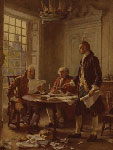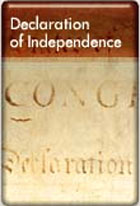The Library of Congress's Interactive Declaration of Independence
The Library of Congress has created a brilliant interactive tool for studying the Declaration of Independence in your classroom. It allows in-depth primary source research while lending itself naturally to reading skills and reinforcing good writing behavior. I explain some of the activities that I used, but there is a wide range of possibilities with this tool.
What is It?
 The template for the computer interactive is a real rough draft of the Declaration of Independence, complete with edits made by Thomas Jefferson, John Adams, and Benjamin Franklin. On the "Overview" page, students can scroll their mouse over Thomas Jefferson's original script, transforming sections from the original handwriting to student-friendly printed font with word-processor-style edits.
The template for the computer interactive is a real rough draft of the Declaration of Independence, complete with edits made by Thomas Jefferson, John Adams, and Benjamin Franklin. On the "Overview" page, students can scroll their mouse over Thomas Jefferson's original script, transforming sections from the original handwriting to student-friendly printed font with word-processor-style edits.
The remaining tabs highlight specific concepts included in the Declaration (All Men Are Created Equal, Pursuit of Happiness, Consent of the Governed, Train of Abuses, and Slavery). For each section, four antecedent sources can be chosen which relate to the same concept and in some cases, use the same words.
Why Do I Love It?
Watching the Declaration warp time zones is equally thrilling for my students and me. It has a magical quality to it. Suddenly the students are excited about reading the Declaration of Independence! The interactive creates the best of both worlds—allowing students to see the original primary source but also helping them to understand it. Not only is the text teaching them history, but the visuals also prompt many critical questions:
They actually had to go back and rewrite this whole thing? What if Jefferson messed up writing at the very end—did he have to start all over? Did they have white-out? Did they use rulers? Where did they learn to write like that? Could everyone write like that?
Students see the handwriting of Jefferson, Adams, and Franklin and suddenly these old guys become real people.
Plus students see the handwriting of Jefferson, Adams, and Franklin and suddenly these old guys become real people. The students develop historic connections outside of the overt goals of the lesson, which I believe is the key to growing lifelong learners.
The interactive allows a range of lesson aims, a variety of historic analyses and skill levels, and a relevant and effective background for reading and writing support. The literacy skills and the focus are up to you but Jefferson is setting the example!
The interactive supports a range of lesson aims and a variety of historic analyses and skill levels, and makes a relevant and effective background for reading and writing extension activities. The literacy skills and the focus are up to you, but Jefferson is setting the example!
How Can I Use It in the Classroom?

My actual lesson included a three-page packet with very specific steps for the students. Below is a sampling of some activities that I used.
Primary Source Observations
The "Overview" page explains what the source is. Once students read this, you can ask a variety of questions about the document. You can use your typical observation format, but due to the large amount of information, I recommend that you select a more narrow focus.
For our initial observations, I asked the students to specifically pay attention to the edits made on page one. The students described what they thought the document was and then were asked about the type of edits.
Ex.: Which of the following did Thomas Jefferson do? (Check all that apply)
◯ Changed words
◯ Added words
◯ Deleted words
◯ Borrowed from other documents
◯ Got peer edits. If so, from whom?
Identifying the Philosophy of Government
The next step was to discover the big ideas Thomas Jefferson communicates in the Declaration. This focused on the tabs labeled "Pursuit of Happiness," "Consent of the Governed," and "All Men are Created Equal," which highlight specific sentences from the document. The students filled in the sections with missing words or translated challenge vocabulary (CH). Note that the gray words are not included.
Ex.: "Consent of the Governed" section
Instituted = Made
Deriving = Getting
Consent = Permission
"that to secure these rights, ___________ [governments] are (CH) ___________ [instituted] among men, (CH) ___________ [deriving] their just powers from the (CH) ___________ [consent] of the governed."
Reading Support
These "Philosophy of Government" sections are ideal for supporting the reading area that your students are working on without confusing them by breaking the flow of your lesson. In my class, the students had to identify either the main idea of each section or Jefferson's purpose in including the sentence. They were therefore practicing testing skills in a way that was relevant and useful to our class. These sections can be applied to just about any reading skill "flavor-of-the-week."
Ex.: "Consent of the Governed" section
Who do you think "the governed" are?
What is Thomas Jefferson's purpose in using this sentence?
a. To inform the readers of how the king rules
b. To describe the Roman government
c. To explain how government should be
d. To support a monarchy government
Reviewing Content
In the next section, I instructed the students to view King George's offenses against the colonies by skimming pages two and three in the "Overview" section. The students' goal was to recognize the significant acts and events that we had discussed. They then recorded the section's specific passages mentioning taxation without representation, the Quartering Act, and the Boston Massacre Trials.
Advanced Source Comparisons
The Library of Congress selected specific reading and research material on Thomas Jefferson and paired it with the sections in the interactive Declaration of Independence. The reading was dense for the majority of my students, but I did ask, in the "All Men Are Created Equal" section, which of the documents they thought fit most closely with Jefferson's words.
The Other Side
On the top of page three, they were shocked to discover "merciless" and "savage."
Once the students are all settled on and happy that Jefferson believes "All Men Are Created Equal," we went backwards and looked a little closer. First, they were instructed to find the words Jefferson used about the American Indians in the text. On the top of page three, they were shocked to discover "merciless" and "savage."
Then we looked closer at the "Slavery" tab which describes the original words about slavery included in the draft of the Declaration of Independence, as well as the fact that they were all deleted. The students answered questions about which states were especially against including slavery and then they made connections. I closed with the questions, "Do you agree with the philosophy of government written in the Declaration of Independence?" and "Do you think the Continental Congress truly agreed with this philosophy of government?"
More Ideas?
If you develop new ways to use this interactive or have success with the Constitution version, please share your experience! I would love to hear some new ideas for this resource.
[Note: If you would like to respond to Liz Schaefer, comment to this entry, or email info@teachinghistory.org. We'll make sure she receives your feedback!]



 The template for the computer interactive is a real rough draft of the Declaration of Independence, complete with edits made by Thomas Jefferson, John Adams, and Benjamin Franklin. On the "Overview" page, students can scroll their mouse over Thomas Jefferson's original script, transforming sections from the original handwriting to student-friendly printed font with word-processor-style edits.
The template for the computer interactive is a real rough draft of the Declaration of Independence, complete with edits made by Thomas Jefferson, John Adams, and Benjamin Franklin. On the "Overview" page, students can scroll their mouse over Thomas Jefferson's original script, transforming sections from the original handwriting to student-friendly printed font with word-processor-style edits. 


